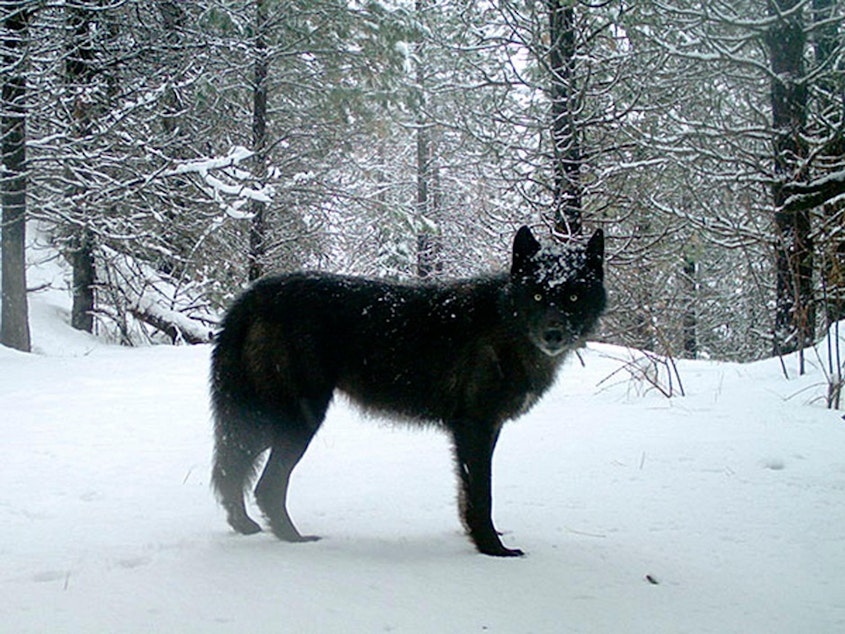Wolf-Delisting Plan Would Remove Federal Protections In Washington And Oregon

President Donald Trump’s acting interior secretary announced plans Wednesday to lift protections for gray wolves in the Lower 48. The move will likely spur controversy in the Northwest.
This Feb. 2017, file photo provided by the Oregon Department of Fish and Wildlife shows a gray wolf of the Wenaha Pack captured on a remote camera on U.S. Forest Service land in Oregon’s northern Wallowa County. CREDIT: OREGON DEPARTMENT OF FISH AND WILDLIFE/APREAD ON
Acting Interior Secretary David Bernhardt made the announcement at a wildlife conference in Denver.
The move was quickly protested by conservation groups across the West, where wolf reintroduction has ignited controversies.
“This disgusting proposal would be a death sentence for gray wolves across the country,” said Collette Adkins, a senior attorney at the Center for Biological Diversity. “The Trump administration is dead set on appeasing special interests that want to kill wolves. We’re working hard to stop them.”
Sponsored
A separate conservation group, however, downplayed the change’s practical effects on wolf recovery in states where wolf numbers have rebounded. Chase Gunnell of Conservation Northwest said his group empathizes with concerns from colleagues in states like California and Colorado, where wolves have not yet recovered.
“However, given the quality of Washington’s wolf plan and investments in collaborative wolf conservation and management work here, we do not expect federal delisting to have a significant impact on wolves in our state,” Gunnell said. “Wolf recovery is progressing well in Washington and our wolves will remain a state endangered species until state recovery goals are met.”
Northwest ranching communities have voiced concerns about the loss of livestock to wolf depredations. Wildlife advocates have said gray wolf protections need to remain in place while they re-establish in their historic ranges.
Wolves were first protected under the Endangered Species Act in 1975. Efforts to re-establish wolves in the United States began in 1995 when wolves from Canada were brought to Yellowstone National Park and the mountains of central Idaho. Nationally, grey wolf numbers in the lower 48 have grown from about 1,000 — all in northern Minnesota — to more than 5,000 in the contiguous U.S.
In the Northwest, federal protections have already been lifted in Eastern Washington and Eastern Oregon, although wolves still receive some protection from state rules. The most recent wolf population numbers reported by the two states are 122 in Washington and 124 in Oregon. Most of the wolves are concentrated in the eastern stretches of the two states, although more recent wolf sightings have been confirmed west of the Cascades around Mount Rainier in Washington and Mount Hood in Oregon.
Sponsored
This newest proposal would mean wolves in the western parts of both states would no longer receive federal Endangered Species Act protections. State protections would remain in place.
Oregon’s wolf plan is in the midst of being updated and that’s been controversial. Earlier this year several environmental groups withdrew from a stakeholders group working on the update. They said the plan was being tilted toward ranchers’ goal: streamlining the process for getting approval to kill wolves suspected of preying on livestock.
U.S. Rep. Dan Newhouse, R-Washington, said the Trump administration proposal is a good step forward for wolf management.
“The best available science shows that the gray wolf has successfully recovered from the danger of extinction and no longer requires federal protection,” Newhouse said in a statement. “We can see in Washington state that the wolf population is growing quickly while being effectively managed by the Washington Department of Fish & Wildlife in the eastern third of the state.
Newhouse had previously sponsored a bill that passed the U.S. House last year, before Democrats took the majority from Republicans, seeking to remove Endangered Species Act protections for gray wolves.
Sponsored
Trump is not the first president whose administration has sought the removal of endangered species protections for gray wolves. the George W. Bush and Barack Obama administrations made similar proposals. In both instances, conservation groups filed lawsuits and courts ruled against de-listing gray wolves as proposed.
Copyright 2019 Northwest Public Broadcasting
Related Stories: [Copyright 2019 Northwest Public Broadcasting]
